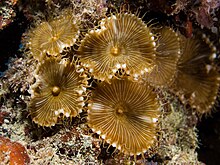Palythoa
| Palythoa | |
|---|---|
 |
|
| Palythoa grandis | |
| Scientific classification | |
| Kingdom: | Animalia |
| Phylum: | Cnidaria |
| Class: | Anthozoa |
| Subclass: | Hexacorallia |
| Order: | Zoantharia |
| Family: | Sphenopidae |
| Genus: |
Palythoa Lamouroux, 1816 |
Palythoa is a genus of anthozoans in the order Zoantharia.
The polyps of Palythoa are partially embedded in an encrusting mat of tissue (coenenchyme) covering the substrate on which the colony grows. The individual polyps have flattened oral discs surrounded by a fringe of tentacles. The tentacles' shape and size can vary considerably between species, and even between colonies of the same species. Their colors are also highly variable, with relatively dull shades like cream, coffee, white, brown, or yellow, being the most common. Fluorescent colored colonies also exist, but these are more rare.
Palytoxin is a highly toxic fatty alcohol produced by many species of Palythoa, and is also found in other corals and certain marine invertebrates. The substance was first isolated from the seaweed-like "limu-make-o-Hana" ("Seaweed of Death from Hana") in 1971 in Hawaii. Scientific investigation of the seaweed found it to be a colonial cnidarian, which was classified as a zoanthid and named Palythoa toxica. Small quantities of palytoxin can be fatal should it be ingested or inhaled.
The presence of this toxin is of significance to aquarists who keep reef aquariums, as Palythoa and related zoanthids are commonly kept as decorative specimens in marine aquaria. Aquarists have reported symptoms consistent with palytoxin poisoning prior to having exposure to zoanthids suspected to contain the toxin. One report involved an aquarist being accidentally poisoned through skin injuries after handling zoanthids Another report involved an aquarium hobbyist in Virginia who experienced a severe respiratory reaction after trying to eradicate colonies of brown zoanthids (suspected to be Palythoa) from rocks in their aquarium. A 2010 study found that a single specimen of Palythoa from a sample of fifteen colonies purchased from three aquarium stores in the Washington D.C. area contained high levels of palytoxin, indicating that toxic individuals are present in the captive population.
...
Wikipedia
